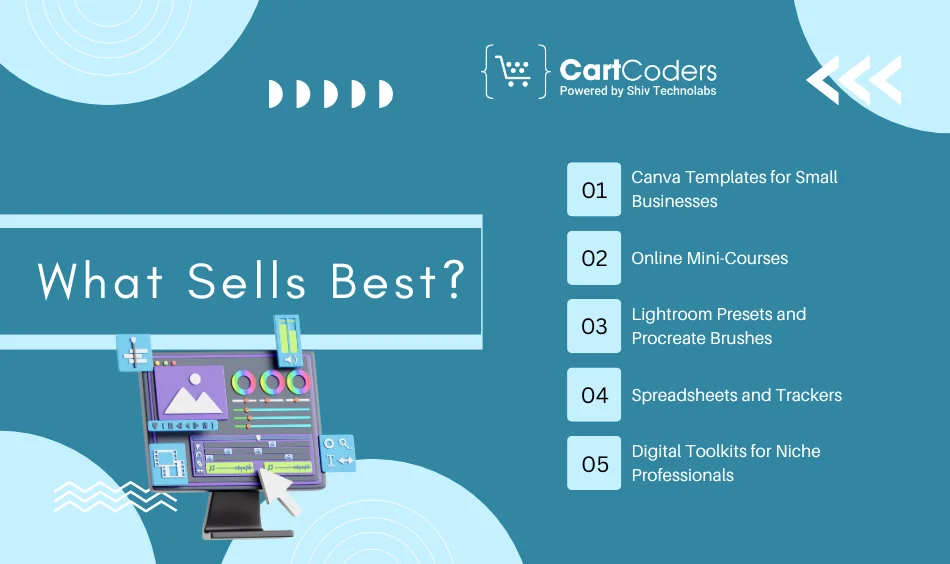Custom Engagement Solutions
Unlock tailored solutions with a free, no-obligation strategy session.
Expert Developers & Engineers on Demand
Scale Your Team with Skilled IT Professionals
Expert Guidance for Digital Transformation
![How to Sell Digital Products Online in 2025 [Step-by-Step].](https://cartcoders.com/blog/wp-content/uploads/2025/07/How-to-Sell-Digital-Products-Online-in-2025-Step-by-Step-950x500.webp)
Thinking about selling digital products online? You’re not alone. From ebooks and design files to music, software, and online courses, digital goods are everywhere now.
The best part? You don’t need a warehouse, shipping labels, or even physical stock.
Selling digital products is one of the easiest ways to earn online. You create it once and sell it again and again. Sounds simple, right? It can be—if you follow the right steps.In this guide, I’ll walk you through everything you need to get started and make sales.
A digital product is anything you can sell and deliver online—no shipping, no packaging, no physical stuff. It’s made once and downloaded or accessed again and again.
Here are some popular examples:
Each type fits a different skill set and target buyer. Some people earn from one standout product. Others build a full store around a niche, like Notion templates for freelancers or presets for mobile photographers.

Selling digital products isn’t about flashy launches or building a huge store on day one. It’s about starting with something small, useful, and well-presented.
Here’s how to do it—step by step.
Pick something you can create without hiring a team. Focus on skills you already have or tools you’re familiar with.
Examples:
Don’t try to cover every category. Pick one thing and shape it well.
You don’t need to guess. Look for signs of demand before you invest time building anything.
Here’s how to test it:
If strangers show interest—or better, share their emails—it’s a green light.
Use beginner-friendly tools to build version one. Don’t worry about perfection. Focus on clarity and function.
Tool examples by product type:
| Product Type | Tools You Can Use |
| Templates | Canva, Google Docs, Figma |
| PDFs & Guides | Canva, Notion, MS Word |
| Online Courses | Loom, Notion, Teachable |
| Audio Files | Audacity, GarageBand |
| SaaS or Tools | Softr, Glide, Bubble, Custom |
Keep file sizes manageable. Always preview them on both desktop and mobile.
Where you sell matters. Some platforms do the heavy lifting for you, while others give more control.
Options to consider:
Don’t overthink it—choose the perfect eCommerce platform that fits your current stage. You can always move later.
Your buyers expect instant access. That means setting up payment and delivery automation from the start.
For example:
Always send a confirmation email with a download link. Double-check that the link works before launching.
People won’t buy unless they understand what they’re getting. Avoid long paragraphs and vague promises.
Instead, include:
Speak like a person, not a product manual. Be helpful and specific.
Digital pricing is flexible, but don’t underprice just to get started. Buyers often link price to quality.
Tips for pricing:
Experiment and adjust. There’s no fixed formula.
Once your product page is ready, hit publish. Share it with the people who showed early interest.
Ways to announce:
Focus on reaching your first 10 buyers. That’s when you’ll start seeing what works—and what needs tweaking.
There’s no shortage of platforms to sell digital products, but not all of them are worth your time. Some are beginner-friendly with built-in features. Others give you more freedom, but require setup.
Here’s a comparison to help you choose:
| Platform | Best For | Pros | Pricing |
| Shopify | Full control and branding | Custom design, app support, SEO tools | Starts at $39/month |
| Gumroad | Quick launches and small catalogs | No setup cost, handles VAT | Free + 10% per sale |
| Payhip | Courses, ebooks, and digital files | Coupons, bundles, EU VAT compliant | Free or $29/month |
| Etsy | Templates, art, and printables | Built-in traffic, easy listings | 6.5% fee + listing fee |
| WooCommerce | WordPress users | Open-source, complete flexibility | Hosting + plugins vary |
Tips for choosing:
Don’t worry about picking the perfect tool. What matters is getting your product in front of people. You can always migrate from existing platforms later when you grow.

Not every digital product sells well. The ones that do tend to solve a specific problem or save people time. You don’t need a massive audience to succeed—you just need something useful and presented.
Here are some products that are working well:
These include social media posts, pitch decks, business cards, and presentation slides.
People love ready-to-edit designs they can use instantly.
Short, focused courses—like “How to Write a Cold Email” or “Notion for Freelancers.”
They don’t require a big curriculum, just useful content and a clear outcome.
Great for photographers and digital artists. These are ready-to-use files people can apply to their work.
Budget planners, fitness logs, subscription trackers, and invoice generators—these save time for freelancers, parents, and side hustlers.
Think HR bundles, legal contracts for freelancers, or brand kits for coaches.
These often command higher prices because they’re specialized.
You don’t need to reinvent anything. Improve an existing idea, make it clearer, or tailor it to a new audience. Focus on quality and usefulness—those two things still win.
If you’re serious about selling digital products and want more than just a quick setup, we can help.
At CartCoders, we build Shopify stores designed specifically for digital goods. That means fast product delivery, clean layout, simple checkout, and the right apps in place from day one.
Whether you’re selling one ebook or an entire library of templates, we’ll help you set up a store that works—and scales when you’re ready.
Want to talk about your idea? Reach out. We’ll help you move from product to store without the usual confusion.
You don’t need to overplan or wait for the perfect time. Start with one product. Focus on making it useful. Pick a platform that fits your pace and launch.
Selling digital products is one of the simplest ways to build income online, but it only works when you begin. So pick an idea, build something real, and share it. You’ll learn faster by doing than thinking.And if you want help setting up a Shopify store that sells, the CartCoders team is just one message away.
Projects delivered in 15+ industries.
95% retention rate, building lasting partnerships.
Serving clients across 25+ countries.
60+ pros | 10+ years of experience.